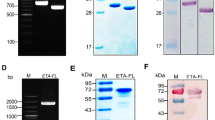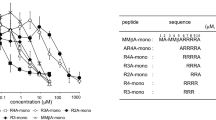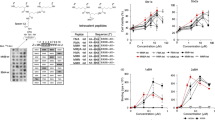Abstract
Exotoxins of Staphylococcus aureus belong to a family of bacterial proteins that act as superantigens by activating a large subset of the T-cell population, causing massive release of inflammatory cytokines. This cascade can ultimately result in toxic shock syndrome and death. Therapeutics targeting the early stage of the pathogenic process, when the superantigen binds to its receptor, could limit the severity of disease. We engineered picomolar binding affinity agents to neutralize the potent toxin staphylococcal enterotoxin B (SEB). A single immunoglobulin-like domain of the T-cell receptor (variable region, Vβ) was subjected to multiple rounds of directed evolution using yeast display. Soluble forms of the engineered Vβ proteins produced in Escherichia coli were effective inhibitors of SEB-mediated T-cell activation and completely neutralized the lethal activity of SEB in animal models. These Vβ proteins represent an easily produced potential treatment for diseases mediated by bacterial superantigens.
This is a preview of subscription content, access via your institution
Access options
Subscribe to this journal
Receive 12 print issues and online access
$209.00 per year
only $17.42 per issue
Buy this article
- Purchase on Springer Link
- Instant access to full article PDF
Prices may be subject to local taxes which are calculated during checkout




Similar content being viewed by others
Accession codes
References
McCormick, J.K., Yarwood, J.M. & Schlievert, P.M. Toxic shock syndrome and bacterial superantigens: an update. Annu. Rev. Microbiol. 55, 77–104 (2001).
Marrack, P. & Kappler, J. The staphylococcal entertoxins and their relatives. Science 248, 705–711 (1990).
Burnett, J.C., Henchal, E.A., Schmaljohn, A.L. & Bavari, S. The evolving field of biodefence: therapeutic developments and diagnostics. Nat. Rev. Drug Discov. 4, 281–297 (2005).
Crass, B.A. & Bergdoll, M.S. Involvement of staphylococcal enterotoxins in nonmenstrual toxic shock syndrome. J. Clin. Microbiol. 23, 1138–1139 (1986).
Lee, V.T., Chang, A.H. & Chow, A.W. Detection of staphylococcal enterotoxin B among toxic shock syndrome (TSS)- and non-TSS-associated Staphylococcus aureus isolates. J. Infect. Dis. 166, 911–915 (1992).
Andrews, M.M., Parent, E.M., Barry, M. & Parsonnet, J. Recurrent nonmenstrual toxic shock syndrome: clinical manifestations, diagnosis, and treatment. Clin. Infect. Dis. 32, 1470–1479 (2001).
Li, H., Llera, A., Malchiodi, E.L. & Mariuzza, R.A. The structural basis of T cell activation by superantigens. Annu. Rev. Immunol. 17, 435–466 (1999).
Kieke, M.C. et al. High affinity T cell receptors from yeast display libraries block T cell activation by superantigens. J. Mol. Biol. 307, 1305–1315 (2001).
Buonpane, R.A., Moza, B., Sundberg, E.J. & Kranz, D.M. Characterization of T cell receptors engineered for high affinity against toxic shock syndrome toxin-1. J. Mol. Biol. 353, 308–321 (2005).
Boder, E.T. & Wittrup, K.D. Yeast surface display for screening combinatorial polypeptide libraries. Nat. Biotechnol. 15, 553–557 (1997).
Maynard, J.A. et al. Protection against anthrax toxin by recombinant antibody fragments correlates with antigen affinity. Nat. Biotechnol. 20, 597–601 (2002).
Razai, A. et al. Molecular evolution of antibody affinity for sensitive detection of botulinum neurotoxin type A. J. Mol. Biol. 351, 158–169 (2005).
Scobie, H.M. et al. A soluble receptor decoy protects rats against anthrax lethal toxin challenge. J. Infect. Dis. 192, 1047–1051 (2005).
Stone, R.L. & Schlievert, P.M. Evidence for the involvement of endotoxin in toxic shock syndrome. J. Infect. Dis. 155, 682–689 (1987).
Horn, D.L. et al. What are the microbial components implicated in the pathogenesis of sepsis? Report on a symposium. Clin. Infect. Dis. 31, 851–858 (2000).
Schlievert, P.M. Enhancement of host susceptibility to lethal endotoxin shock by staphylococcal pyrogenic exotoxin type C. Infect. Immun. 36, 123–128 (1982).
Holt, L.J., Herring, C., Jespers, L.S., Woolven, B.P. & Tomlinson, I.M. Domain antibodies: proteins for therapy. Trends Biotechnol. 21, 484–490 (2003).
Olafsen, T. et al. Optimizing radiolabeled engineered anti-p185HER2 antibody fragments for in vivo imaging. Cancer Res. 65, 5907–5916 (2005).
Wu, A.M. & Senter, P.D. Arming antibodies: prospects and challenges for immunoconjugates. Nat. Biotechnol. 23, 1137–1146 (2005).
Hoogenboom, H.R. Selecting and screening recombinant antibody libraries. Nat. Biotechnol. 23, 1105–1116 (2005).
Holliger, P. & Hudson, P.J. Engineered antibody fragments and the rise of single domains. Nat. Biotechnol. 23, 1126–1136 (2005).
Kaneko, Y., Nimmerjahn, F. & Ravetch, J.V. Anti-inflammatory activity of immunoglobulin G resulting from Fc sialylation. Science 313, 670–673 (2006).
Soo Hoo, W. & Kranz, D.M. Role of CD8 in staphylococcal enterotoxin B-mediated lysis by cytotoxic T lymphocytes. J. Immunol. 150, 4331–4337 (1993).
Reed, L.J. & Muench, H. A simple method of estimating fifty per cent endpoints. Am. J. Hyg. 27, 493–497 (1938).
Parsonnet, J., Gillis, Z.A., Richter, A.G. & Pier, G.B. A rabbit model of toxic shock syndrome that uses a constant, subcutaneous infusion of toxic shock syndrome toxin 1. Infect. Immun. 55, 1070–1076 (1987).
Roggiani, M., Stoehr, J.A., Leonard, B.A. & Schlievert, P.M. Analysis of toxicity of streptococcal pyrogenic exotoxin A mutants. Infect. Immun. 65, 2868–2875 (1997).
Acknowledgements
We thank D. Levitt for advice on the pharmacokinetic studies, R. Mariuzza for discussions regarding SAgs and S. Bavari for discussions regarding animal models of toxic shock syndrome. These studies were supported by the US National Institutes of Health (grant AI064611 to D.M.K.). B.M. is a recipient of the Boston Biomedical Research Institute Scholar Award. R.A.B. was partially supported by a US National Institutes of Health training grant (T32 GM 07283).
Author information
Authors and Affiliations
Contributions
R.A.B. engineered the final generation of Vβ clones, expressed the Vβ proteins in E. coli, conducted the in vitro neutralization experiments, and helped to draft the manuscript. H.R.O.C. engineered the initial generations of Vβ clones and conducted yeast display experiments. B.M. and E.J.S. conducted the surface plasmon resonance experiments and drafted some sections of the manuscript. M.L.P. conducted the pharmacokinetic studies and evaluated the data. P.M.S. conducted the rabbit experiments, evaluated the data and drafted some sections of the manuscript. D.M.K. helped to design the experiments by R.A.B. and H.R.O.C., evaluated data and drafted the manuscript. All authors provided comments on the final manuscript.
Corresponding author
Ethics declarations
Competing interests
The authors declare no competing financial interests.
Supplementary information
Supplementary Fig. 1
Analysis of Vβ8 mutants for SEB binding at different stages of affinity maturation. (PDF 103 kb)
Supplementary Fig. 2
Equilibrium SEB binding titration of clones at different stages of affinity maturation. (PDF 139 kb)
Supplementary Fig. 3
Surface plasmon resonance analysis of affinity matured Vβ8.2 clones. (PDF 164 kb)
Supplementary Fig. 4
Serum clearance of 125I-Vβ in the presence or absence of SEB. (PDF 54 kb)
Supplementary Table 1
Yeast display library sizes. (PDF 59 kb)
Supplementary Table 2
SEB binding and in vitro inhibitory properties of Vβ8 affinity matured variants. (PDF 96 kb)
Supplementary Table 3
Biodistribution of 125I-labeled Vβ in rabbits three hours after injection. (PDF 57 kb)
Rights and permissions
About this article
Cite this article
Buonpane, R., Churchill, H., Moza, B. et al. Neutralization of staphylococcal enterotoxin B by soluble, high-affinity receptor antagonists. Nat Med 13, 725–729 (2007). https://doi.org/10.1038/nm1584
Received:
Accepted:
Published:
Issue Date:
DOI: https://doi.org/10.1038/nm1584
This article is cited by
-
Staphylococcus aureus Toxins: From Their Pathogenic Roles to Anti-virulence Therapy Using Natural Products
Biotechnology and Bioprocess Engineering (2019)
-
Staphylokokken bei chronischer Rhinosinusitis mit Nasenpolypen
Allergo Journal (2012)
-
Generation and characterization of high affinity human monoclonal antibodies that neutralize staphylococcal enterotoxin B
Journal of Immune Based Therapies and Vaccines (2010)
-
Editors' Picks
Journal of Investigative Dermatology (2007)
-
Research highlights
Nature Biotechnology (2007)



